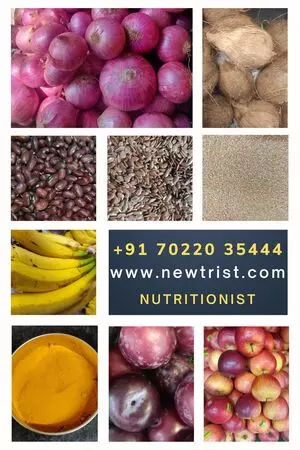Newtrist Nutritionist Lichen Planus Diet Plan should include vegetables and fruits (non-citrus) rich in vitamins and minerals, antioxidant-rich foods, fat-free poultry, fish, and foods rich in healthy fats such as omega-3 fatty acids. Folate should be an essential part of the daily diet.
- Early morning drink @ 6:30 am: Tulsi drink
- Breakfast @ 9 am: Oatmeal with chopped apples and bananas
- Mid-morning meal @ 11 am: Yogurt with cut fruits
- Lunch @ 1 pm: Soft cooked rice with dal tadka and stir-fried okra
- Evening snack @ 4 pm: Coconut milk with finely chopped tender coconut pieces
- Dinner @ 7 pm: Moong dal idly with non-spicy sambhar and turmeric milk at bedtime
Best Nutritionist in Bangalore
Consult 19-year-experienced Chief Nutritionist Vasanthi, in person at HSR, Koramangala, Bellandur, Haralur, Electronic city, or online across India.

Table of Contents
What is Lichen Planus?
Lichen Planus is a non-contagious disease characterized by the inflammation of the skin or the mucus membranes of the oral cavity. The word “Lichen” is derived from a plant named Lichen which grows on the rocks and barks of trees in the form of plaques. Planus means flat. Lichen Planus is symptomized as pink or purple lesions with intense itchiness which may develop into thick plaques.
The lesions may be seen anywhere in the body but it is most commonly found in the scalp, mouth, nails, skin, and genitals. The lesions may spread all over the body and cause pain, or a burning sensation. Women are more prone to this disease when compared to males.
The main cause of the disease is unclear, whereas some factors may trigger the onset of the disease which may be due to the allergic reaction caused due to medicines, exposure to chemicals, stress, and genetic factors.
A dentist or a dermatologist may physically examine your mouth and skin for any lesions and confirm with a biopsy test. If your biopsy test shows Lichen Planus but you are asymptomatic, no treatment is required. If itching or sores persist, treatment can help. Mild Lichen Planus may go away on its own within 2 years.
What are the symptoms of Lichen Planus?
The symptoms of Lichen Planus include
- Red to purple-colored lesions or bumps
- Blisters filled with whitish-blue fluid
- Itchiness
- The chalky appearance of the nails
- Splitting and scarring of the nails
- Tiny white patches on the tongue and the inside of the cheeks
- Thickening of the epidermis in the mouth
- Peeling on the gums
- Change of taste
- An unpleasant odor from the bumps or blisters
Mouth sores affect intake of food which may lead to nutritional deficiencies. Lichen Planus on the vagina and vulva may be painful and difficult to treat. Severe untreated lichen planus may cause the patient more susceptible to oral cancer. Lichen Planus may be sometimes seen in the ear canal which might increase the risk of hearing loss if untreated.
The spots may appear as tiny raised dots and spread as the condition progresses. bruises may be seen on the tongue, lips, and inside of the cheeks.
What are the stages of Lichen Planus?
The stages of Lichen Planus are classified as
- Early Lichen Planus
- Active Lichen Planus
- Resolving Lichen Planus
- Resolved Lichen Planus
What are the types of Lichen Planus?
The different types of Lichen Planus are
- Oral Lichen Planus
- Nail Lichen Planus
- Linear Lichen Planus
- Annular Lichen Planus
- Atrophic Lichen Planus
- Hypertrophic Lichen Planus
- Inverse Lichen Planus
- Eruptive Lichen Planus
Oral Lichen Planus is a common type of Lichen Planus that is seen along with skin lesions. This type of Lichen Planus may cause damage to the mucosal keratinocytes and immune cells. Oral Lichen Planus can be in the form of erosions, plaques, reticular or atrophic forms.
Nail Lichen Planus is seen both on fingernails and toenails. Longitudinal ridges, pitting of the nails, splitting, and brown discoloration of the nails are present in this type of Lichen Planus. Progression of the disease may bring changes in the nail matrix and affect the nail bed.
Linear lichen Planus is a rare type of Lichen Planus where a linear presentation of the classical lesions is reported.
Annular Lichen Planus is another form of classical Lichen Planus. 3-7% of patients with Lichen Planus have this type of variant. Red to purple circle-shaped papules or plaques with raised borders are observed.
Atrophic Lichen Planus is a rare type of Lichen Planus with the recurrence of plaques in the previously affected areas. Cutaneous lesions with whitish-blue or brown papules occur accompanied by pain and progression to dark brown macules.
Hypertrophic Lichen planus, also known as Lichen Planus Hypertrophicus, shows the presence of thick papules. The Hypertrophic Lichen Planus may appear on the hands, legs, and trunk regions. Treatment is achieved with the help of steroid injections in combination with cryotherapies.
Eruptive Lichen Planus also called Generalized Lichen Planus which is caused mainly due to the influence of external factors.
Lichen Planus Diet Plan
The Lichen Planus diet plan is found below.
- Early morning drink @ 6:30 am: Aloe vera juice
- Breakfast @ 9 am: An avocado sandwich with turmeric tea
- Mid-morning meal @ 11 am: Sesame-Flaxseed laddoo
- Lunch @ 1 pm: Cauliflower rice with boiled and sauteed kidney beans
- Evening snack @ 4 pm: Apple-Carrot smoothie
- Dinner @ 7 pm: Dal khichdi with vegetables

Foods to avoid with Lichen Planus
Foods to avoid with Lichen Planus are
- Spicy foods
- Citrus fruits
- Tomatoes
- Spinach
- Packaged cereals
- Dry fruits
- Almonds
- Potatoes
- Beetroots
- Turnips
- Soy products
- Cocoa powder
- Hot chocolate drink
- Peanuts
- Peanut butter
- Fried foods
- Vinegar
- Tamarind
- Sugary foods
- Refined foods
- Canned fruits
- Rice bran
- Eggs
Consuming hot and spicy foods which include chili peppers, spicy gravies, tomatoes, and other curries that use more amounts of ginger and garlic can aggravate Lichen Planus. It is advised to limit the consumption of caffeinated drinks such as coffee, tea, green tea, cola drinks, and aerated beverages to prevent the symptoms from getting worse.
Hard and crispy foods might hurt open sores and cause discomfort. Avoid eating crusty bread, chips, crunchy cookies, and fried foods that are hard and crunchy in texture.
Refrain from eating salty foods such as pickles, papads, fryums, soy sauce, and other foods that may cause irritation of the sores and prevent you from consuming healthy nutritious foods.
Best vegetables for Lichen Planus
The best vegetables for Lichen Planus are
- Carrots
- Cauliflower
- Sweet potatoes
- Broccoli
- Asparagus
- Lettuce
- Pumpkin
- Garlic
- Onions
- Green peas
- Gourd vegetables
- Ladies finger

Include vegetables that are cooked to perfection, soft and mushy to prevent discomfort and irritation of the lesions. Vegetables supply the body with essential vitamins, minerals, and fiber, the restriction of certain vegetables like tomatoes, spinach, beetroot, and other vegetables can make you lack many nutrients.
Best fruits for Lichen Planus
The best fruits for Lichen Planus are
- Apples
- Pears
- Plums
- Bananas
- Avocados
- Papaya
- Mangoes
- Pomegranates
- Ice apples
- Custard apples
Fruits provide a lot of vitamin A and other essential minerals. Consuming fruits boost the immune system and fight inflammation. Fruits help you to stay away from processed foods which may be the root cause to aggravate inflammation.
Avocados are great sources of omega-3 fatty acids which promote skin health and help in maintaining healthy skin free from diseases.
Tips for Lichen Planus
Here are a few useful tips to manage your Lichen Planus.
- Choose foods that are soft and easy to chew to manage the intake of all essential nutrients.
- Proper hydration with adequate water and fluids prevents dryness of the mouth and keeps it hydrated.
- A mixture of oatmeal powder and warm water can soothe the itchiness of the skin rashes.
- Corticosteroid ointments such as hydrocortisone creams are used to relieve pain.
- Aloe vera is an excellent moisturizer for treating and healing sores. Aloe vera can relieve the symptoms of Lichen Planus on the mouth and vulva.
- Practicing good oral hygiene such as brushing your teeth twice a day and dental floss can prevent exacerbation of the symptoms of Lichen Planus.
- Turmeric ointments, tea tree oils, Epsom salt baths, oil pulling with coconut oil, vitamin A-rich foods, exposure to the sun to avail vitamin D, and effective stress management can help in treating the condition.
- Avoid scratching the scalp and skin and take proper care of your nails.
- Applying coconut oil to the affected areas improves symptoms and relieves itching. Oil pulling expels the toxins out of the mouth.
Foods to prevent Lichen Planus
Foods to prevent Lichen Planus are healthy foods such as fruits, vegetables, whole grains, pulses, legumes, lean chicken, fish, and foods rich in omega-3 fatty acids. However, no specific foods can prevent the occurrence of Lichen Planus.
Book a consultation with our expert nutritionists for a perfect meal plan and the foods to avoid for Lichen Planus. Certain foods such as highly spicy foods, acidic foods, hot beverages, and salty foods need to be avoided for lichen Planus.
Intake of legumes, grains, and antioxidant-rich foods strengthens the immune system and prevents the risk of acquiring the disease. Practicing good hygiene can prevent the aggravation of the disease.
A deficiency of vitamin D and vitamin B12 can be a risk factor for Lichen Planus. Consumption of foods rich in vitamins and minerals may prevent the malignant transformation of Lichen Planus.
Lichen Planus FAQs
Is Lichen Planus curable?
Lichen Planus cannot be completely cured, but living with it is not tedious. Mild Lichen Planus can be cured with topical corticosteroid ointments and creams which relieve the itchiness and controls the rashes. Dietary modifications such as staying away from spicy and acidic foods can alleviate the patches found in the tongue and cheeks of an infected person.
Is Lichen Planus a serious condition?
Lichen Planus is not a serious condition but it may cause discomfort during its early stages. Untreated severe forms of oral Lichen Planus may lead to mouth cancers. Painful sores, itchiness, and permanent scaring can result due to untreated Lichen Planus. Emotional stress can make Lichen Planus worse.
What are the best foods to eat for Lichen Planus?
Vegetables, non-citrus fruits, whole grains, millet, soft-cooked beans, and legumes, skinless chicken (without hot spices), and foods rich in omega-3 fatty acids such as avocados, fish, and olive oil are some of the best foods for Lichen Planus. Refrain from consuming hot beverages, caffeinated drinks, spicy foods, and acidic foods to refrain from the discomfort caused due to foods.
What is the natural remedy for Lichen Planus?
Maintenance of oral hygiene is essential for Lichen Planus. Make changes in the diet. Avoid spicy and acidic foods if you notice worsening symptoms. Manage stress. Avoid foods that cause irritation to the wounds and lesions and have regular visits with your doctor/Dentist regularly. Reduce the exposure of chemicals that have been used to develop color photographs.
How can I reduce Lichen Planus?
Phototherapies are the latest treatment for Lichen Planus. It uses light rays to clear up the lesions and rashes. The doctors prescribe corticosteroid ointments or oral pills which act as immunosuppressants that reduce the response of the immune system. The CO2 laser is used in the treatment of Lichen Planus to reduce rashes and other symptoms.
Are proteins and vitamins good for Lichen Planus?
A balanced meal rich in proteins and vitamins is required to maintain stamina and carry out day-to-day activities. The menu restricts many foods due to their acidic and sour nature of them. Reduce the number of spices such as chilies, cinnamon, cloves, and pepper to the chicken while you cook them. Include chicken, fish, and other animal foods as they are rich sources of proteins (red meats and processed meats are to be excluded).
What are the first signs of Lichen Planus?
Itchiness, tiny white spots on the tongue and inner side of the cheeks, blisters filled with fluid, an unpleasant odor from the pus or fluid, scarring and splitting of the nails, temporary or permanent loss of nails, redness and irritation of the scalp, thinning of hair, permanent hair loss in the form of patches are some of the signs of Lichen Planus. The bumps turn into thick patches of skin that are rough and scaly.
How can I treat Lichen Planus at home?
· Add oats powder, honey, and warm water to a bowl, mix well, and apply the paste to the affected areas. This technique works well to relieve itchiness of the skin.
· A mixture of aloe vera and turmeric provides moisturization and prevents dryness of the skin. Turmeric acts as a natural antibiotic that treats skin problems.
· Applying neem paste with a few drops of castor oil also works efficiently for the cure of skin Lichen Planus.
· Oil pulling with coconut oil improves oral health and related disorders.
How to reverse Lichen Planus?
Lichen Planus is a life-long condition in which the symptoms can be reversed with dietary modifications and medications. Restriction of foods that cause irritation and allergies to the affected areas is essential to reverse Lichen Planus. Consumption of foods rich in vitamin A and folate improves skin health and prevents redness and itching. Corticosteroid ointments and pills (in severe cases) can speed up the recovery and healing of lesions and blisters.